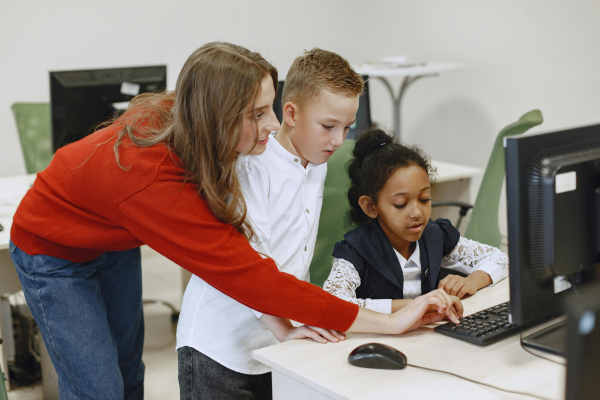
eTwinning projects as an effective pathway to digital skills

When pupils learn together online, their digital competencies tend to develop organically. This is why eTwinning provides the ideal context not just for improving technical IT skills but also for building wider digital literacy skills, such as e-safety and digital citizenship.
Inspiring eTwinning projects
These projects are great examples of successful collaboration, and have been awarded the European Quality Label.
In the Clapperboard project, pupils created audiovisual productions (such as short films or documentaries) that presented environmental issues in their countries. This helped pupils learn digital skills using electronic devices and video and audio editing tools.
In the BrAInY project, secondary school pupils worked in international teams to create thematic educational boxes based on their interests. They made use of artificial intelligence (AI), explored the concept of ‘netizenship’ (internet + citizenship) and practiced the responsible use of ICT tools for learning and collaborating.
‘Integrating this eTwinning project into our school digital plan has been instrumental in fulfilling our broader digital education goals.
It has allowed us to align with the European Digital Competence Framework (DigComp) while promoting cross-cultural collaboration, project-based learning and meaningful use of digital tools.’
– Idoia Zapirain (project cofounder) and Kasia (project partner)
Connecte-ED in Digit@lotropolis used digital cooperation to connect schools across Europe. Pupils immerse themselves in a virtual city where they explore, learn and create collaboratively in a digitally rich environment. Pupils develop their creativity in activities using innovative digital tools such as augmented reality (AR) and virtual reality (VR).
In the Digital World, Literate Kids and Our secure digital tracks projects, pupils explore how to use the internet wisely, safely and ethically. They learn to evaluate media content and understand the effects of their own media behaviour (copyright issues, illegal downloads, risky use of social media).
‘As a teacher, I was inspired to rethink my approach – integrating digital innovation into daily lessons, personalising learning and promoting active, student-led collaboration.
The project became a model of how technology can transform education into a dynamic, inclusive and future-ready experience.’
–Romina Marchesani (teacher and eTwinning ambassador)
Project kits for digital citizenship
These two eTwinning project kits are designed to support the development of digital competencies.
- Digital citizenship gallery: This project kit provides creative ways to support secondary school students in becoming responsible digital citizens. It includes interactive activities such as group discussions, quizzes, and concept maps to help pupils strengthen their digital literacy.
- Better e-safe than sorry: The aim of this project kit is to raise awareness of online safety in schools. Pupils research online safety issues, survey their peers and produce materials about what they discovered to raise online safety awareness in their school.
Join the eTwinning featured group
You can explore activities, resources and ideas to reinforce your own and your pupils’ digital competence by joining the featured group Digital skills for pupils and teachers (including artificial intelligence and SELFIE tools).
A webinar on 16 June organised by this group will explore online safety and the use of AI in eTwinning projects. Join the group and enrol in the webinar!
Additional information
-
Education type:Early Childhood Education and CareSchool EducationVocational Education and Training
-
Evidence:N/A
-
Funding source:European Commission
-
Intervention level:N/A
-
Intervention intensity:N/A
-
Participating countries:AzerbaijanCroatiaCzechiaGreeceHungaryItalyJordanNorth MacedoniaPolandPortugalRepublic of MoldovaRomaniaSpainTürkiye
-
Target audience:TeacherStudent TeacherHead Teacher / PrincipalTeacher Educator
-
Target audience ISCED:Early childhood education (ISCED 0)Primary education (ISCED 1)Lower secondary education (ISCED 2)Upper secondary education (ISCED 3)
